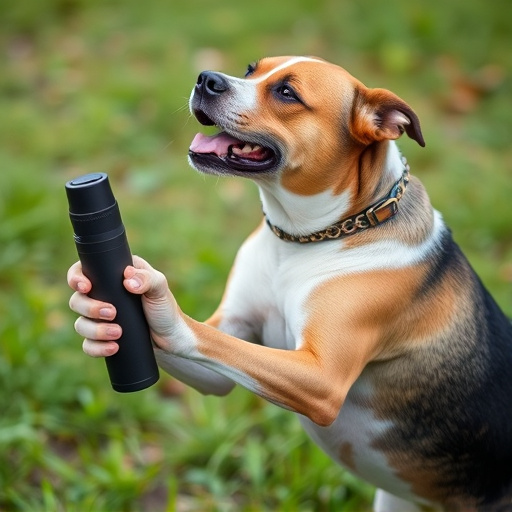Dog pepper spray, a capsaicin-based deterrent, is legally restricted in many US states due to animal welfare concerns and potential misuse. While some areas allow it for personal protection, strict regulations, and guidelines are in place, especially in Dog Pepper Spray Restricted States. These laws aim to protect citizens and animals from harm. Non-compliance can result in penalties. Alternatives to pepper spray include humane training techniques and non-violent devices that redirect animal behavior without resorting to force, offering ethical solutions for managing animal behavior.
“Unleashing control with a precise tool: Exploring Dog Pepper Spray and its Impact on Restricted States. In this comprehensive guide, we delve into the world of dog pepper spray, offering a detailed overview for pet owners and professionals alike. From understanding its mechanism to navigating legal considerations in restricted states, we provide insights on effective application and safety. Furthermore, we uncover alternatives to pepper spray, emphasizing training and non-lethal methods. Discover how these strategies foster safer interactions with animals, especially in areas with stringent regulations.”
- Understanding Dog Pepper Spray: A Comprehensive Overview
- Legal Considerations: Dog Pepper Spray in Restricted States
- Application and Safety Guidelines for Dog Pepper Spray
- Alternatives to Pepper Spray: Training and Non-Lethal Methods
Understanding Dog Pepper Spray: A Comprehensive Overview
Dog pepper spray, a non-lethal deterrent, is designed to temporarily incapacitate dogs without causing serious harm. It’s crucial to understand its effectiveness and restrictions before considering its use. This potent spray utilizes capsaicin, the same compound found in chili peppers, to induce a burning sensation in a dog’s eyes, nose, and throat, leading to temporary disorientation and compliance.
While widely available for personal protection against aggressive dogs, dog pepper spray usage is subject to varying legal restrictions across different states. Some states have banned or severely restricted its use due to concerns about animal welfare and potential misuse. It’s essential to check local laws before purchasing or using dog pepper spray to ensure compliance with regulations, especially in areas where it may be illegal for civilians to possess or deploy such devices.
Legal Considerations: Dog Pepper Spray in Restricted States
In many regions, dog pepper spray is subject to strict regulations due to its potent nature and potential impact on both dogs and humans. The legal considerations around Dog Pepper Spray in Restricted States vary widely, with some states completely prohibiting its use for anything other than law enforcement purposes. These restrictions are often put in place to protect citizens from misuse and accidental harm, as well as to ensure that such products are employed only by trained professionals who understand their risks and effects.
When considering the purchase or use of dog pepper spray in Restricted States, it’s crucial to familiarize yourself with local laws and regulations. Non-compliance can result in severe penalties, including fines and legal action. Additionally, understanding these rules is essential for responsible pet ownership and ensuring that any deterrent measures taken are both effective and within legal bounds.
Application and Safety Guidelines for Dog Pepper Spray
Dog pepper spray, also known as capsaicin-based dog deterrents, is a controversial tool in animal control. While some states allow their use for personal protection against aggressive dogs, others have implemented restrictions or outright bans due to safety concerns and potential misuse. It’s crucial to understand the application and safety guidelines when considering dog pepper spray.
When using dog pepper spray, always follow manufacturer instructions precisely. Aim for the eyes and face of the attacking dog, as capsaicin is most effective in this area. Keep in mind that wind can affect spray direction, so ensure you’re in a position where the breeze won’t carry the spray back towards you or bystanders. Storage is equally important; keep the spray out of reach of children and pets, and store it in a cool, dry place to maintain its effectiveness. Be aware of restrictions in your state regarding dog pepper spray, as some states have specific guidelines on who can possess and use them, and where they can be deployed to avoid misuse.
Alternatives to Pepper Spray: Training and Non-Lethal Methods
In many situations, animal control professionals and enthusiasts prefer non-lethal methods to handle problematic animals. While pepper spray has been a popular choice for its quick effect, there are alternatives that are both effective and humane. Training plays a significant role here; teaching animals to associate certain actions or environments with discomfort or fear can be highly successful in preventing aggressive behavior. Positive reinforcement techniques, along with specialized training aids, can help redirect an animal’s behavior without resorting to force.
Additionally, non-lethal devices like air horns, laser pointers, and water guns are becoming more common. These tools startle animals without causing physical harm. It’s crucial to note that the use of dog pepper spray is restricted in several states due to concerns about its impact on animal welfare and human safety. As such, exploring these alternatives can be a more responsible and effective approach for managing and controlling animal behavior.
In conclusion, while dog pepper spray offers a non-lethal solution for controlling aggressive canine behavior, its usage is subject to strict legal considerations in many restricted states. Despite alternatives like training and non-lethal methods being available, understanding the range and safety guidelines of dog pepper spray remains crucial for those who prioritize animal welfare and community safety.
